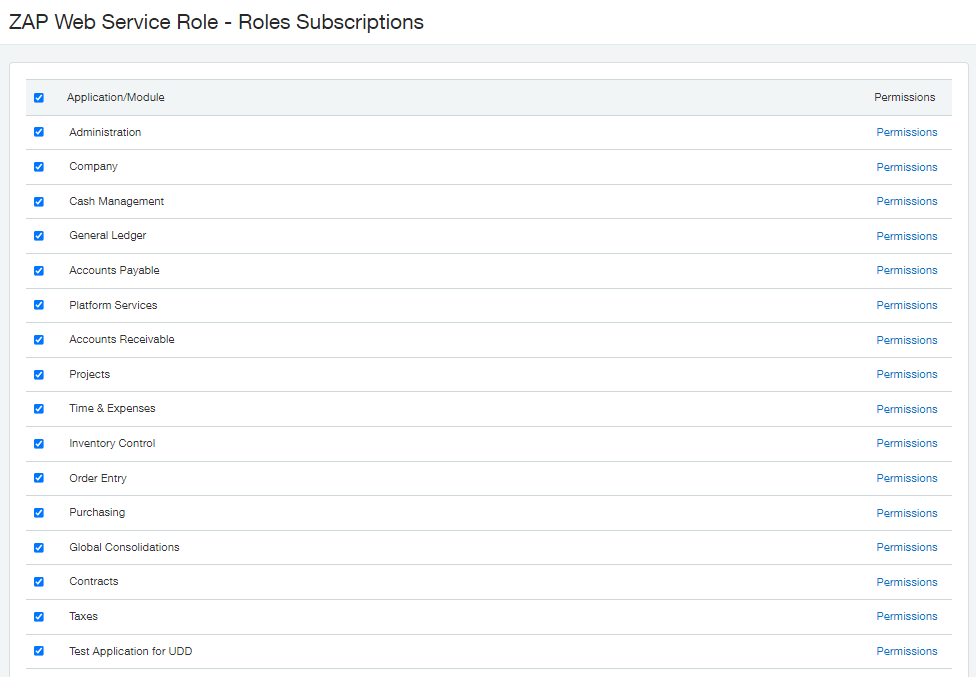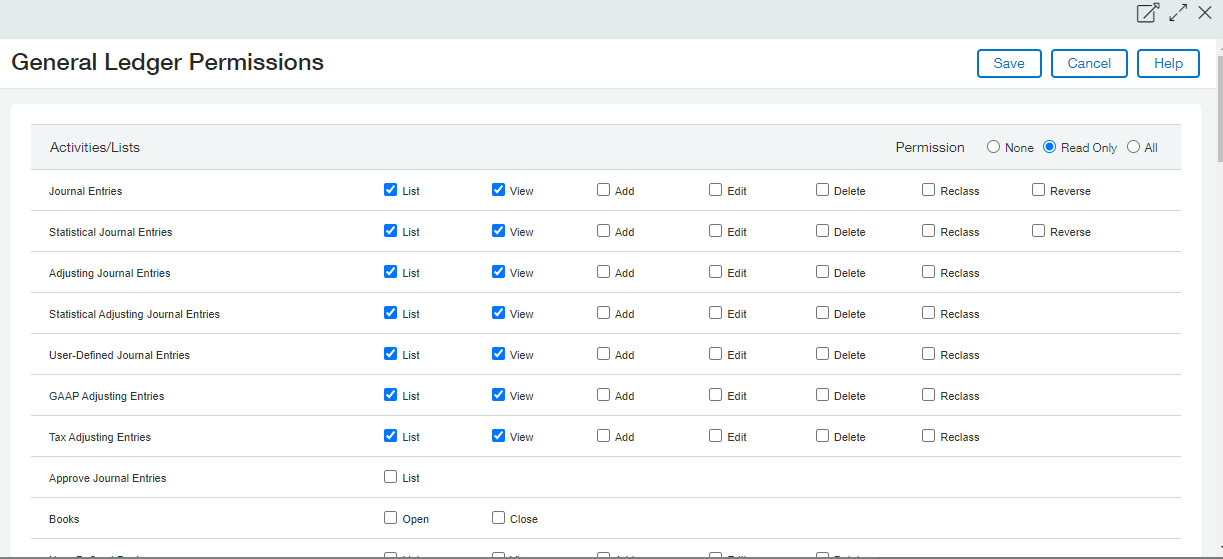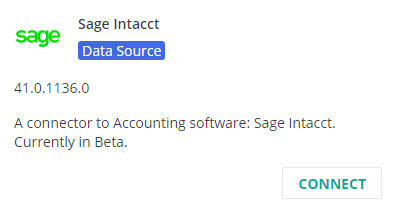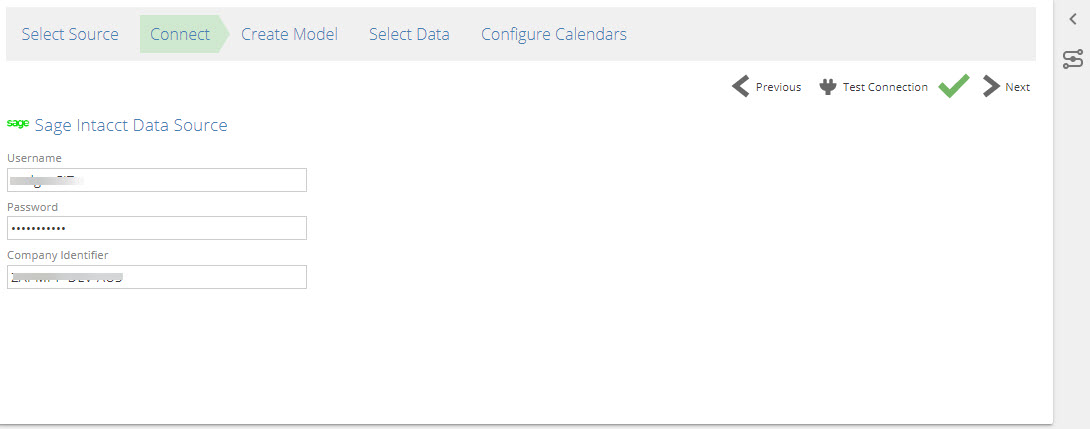Sage Intacct
This guide details the supported features as well as the minimum configuration required to connect to Sage Intacct from the ZAP Intacct connector. Several other information such as error troubleshooting and best practices are also included in this guide.
Supported features
The ZAP connector for Sage Intacct models all endpoints, as exposed by Sage Intacct in the new API. This means that Legacy API endpoints are not displayed in ZAP. Table definitions are dynamically retrieved. Any changes you make, such as adding a new table (e.g. Custom Dimensions – UDDs), or adding new columns (e.g. Custom Attributes), or changing the data type of a column, will immediately be reflected.
By default, ZAP does not make use of Sage Intacct's Data Delivery Services (DDS). If you have purchased DDS from Sage and require using it, please contact your partner or ZAP Support for more information.
The ZAP connector for Sage Intacct automatically retries in the event of a API timeout. The initial migration may be slow as the connector paginates the results of its requests, based on limits and restrictions imposed by the Sage Intacct API, as documented in the Sage Intacct API Developer Webservices page.
ZAP recommends visiting the Sage Intacct developer blog to keep track of added or deprecated features.
Pre-requisites
ZAP Data Hub in the cloud, or ZAP Data Hub On-premises version 10 and above.
An active instance of Sage Intacct
An administrator account, to configure Sage Intacct
In order to connect the ZAP connector for Sage Intacct, it is required to configure the following directly in Sage Intacct:
Subscribe to Web Services
Authorize the ZAP SenderID to make requests to your company’s data
Create or configure user permissions
Configuring access is your responsibility. ZAP provides general guidance in this article, and only offers limited assistance for the following steps which are subject to change by Sage Intacct.
Configuration
Subscribe to Web Services
To enable Web Services access in your Sage Intacct instance, please follow these steps:
From the menu, navigate to Company -->> Admin tab -->> Subscriptions
At the bottom of the list, locate Web Services and click its slider to subscribe

Ignore the warning about additional charges
Click Done on the Subscriptions page to apply your change
Authorize ZAP's Sender ID
To enable Web Service access to ZAP, add the ZAP Sender ID to the allowed list, by following the next steps:
From the menu, navigate to Company -->> Setup tab -->> Company
Click Edit
Click on the Security tab
Go to the section labeled Web Services authorizations
Click the Add button
Enter ZAP (in uppercase) in the Sender ID box, and click Save

Click Save on the Company information page.
Create or configure user permissions
ZAP’s connector for Sage Intacct requires a user with the following minimum permissions. Two types of users may be used:
Web Services user: Sage Intacct supports a different type of user account optimized for web service integrations. It is strongly recommended to use a web service user in order to prevent LOCKEDOUT scenario with a standard user, as multiple logins from multiple locations may occur.
Standard User: A standard user account, requiring the List and View permissions to the necessary API endpoints.
The following steps involve the creation of a dedicated Web Services user. Existing Roles may be assigned to this user, or a new dedicated Role may be created, then assigned to the user.
Creating a dedicated Role has the benefits of only restricting permissions to the endpoints required by ZAP, and also limiting access to just read only List and View permissions, which ZAP requires as a minimum.
Create a Web Services user
From the menu, navigate to Company -->> Admin -->> Web Service users

Click Add
On the User information tab, input values for the following mandatory fields:
User ID
Last name
First name
Email address
Select Business as the User type
Keep the value Off for Admin privileges (recommended)
Click on the Roles information tab and select the applicable Role(s):
You may use existing Role(s) for a quick setup,
Or proceed to the recommended approach of creating and assigning a “read-only” Role
Click Save on the main page
Ignore any warning that there will be a charge for creating the User
Create a dedicated read-only Role
From the menu, navigate to Company -->> Admin tab -->> Roles
Click Add, to create a new Role
Input a Name for your Role, and click Save

Check the necessary boxes on each required module

Click Permissions on an applicable module
Click the Read Only toggle button to automatically give List and View access to Activities/Lists.

Click Save
Repeat Step 6 and 7 for every other applicable module
Click Save to save your Web Service Role.
Connecting to the data source
To add an Intacct data source to an EXISTING Data Model:
Open an existing Data Model from RESOURCE EXPLORER.
Expand Data Sources.
Click Add Data Source.
To add an Intacct data source to an NEW Data Model:
Select source
In the Select Source step:
Under the Apps (API) section, select Sage Intacct.
From the source type pop-up, click Connect on the Sage Intacct entry tagged Data Source.

Connect
To set up the connection between Data Hub and Sage Intacct complete the following fields:
Provide your Username, password and company identifier. Go to Configuration to understand how to configure company information and user access.
Click Test Connection

Click Next to continue to the Create Model step.

Once the model name and location have been specified, click Next to continue to Data selection.
Select data
Select tables to be added as pipelines using the check box column.

If the Finish button was not used to add pipelines, click Finish to complete adding the Sage Intacct data source.
Select data screen elements
Select Data screen contains the following elements:
Select All/Clear
If no table check boxes are currently selected: Select All can be used to select all of the tables in the source database.
If one or more table check boxes are selected: Clear (x) can be used to clear all the selected tables.
Show selected tables only - Hides all tables where the check box column is currently cleared (not selected).
Show tables without rows - When selected, this item shows all source tables, including tables that do not contain data.
Add Pipelines - Select Add Pipelinesto add all selected tables to the data model as individual pipelines. The Add Pipelines drop-down menu provides two options:
Add Pipeline as Union of Tables creates a single pipeline from the union of selected tables from this data source.
Add Pipelines is the same function as the Add Pipelines button.
Note
If all of the tables in the data source are selected, the pipeline will always perform a union on all tables from the data source, even if the table list changes. For example, if the data source contains only tables of sales for USA, UK, and Europe, selecting them all will union the three tables into a single pipeline. If a fourth table with sales for Australia is later added, it will automatically be included in the union for the pipeline.
Finish - Adds the selected tables as individual pipelines and finalizes adding the SAP Business One data source. Once the request has been processed, Data Hub opens the Data Model Overview.
The filter row - The first row of the Select Data table is the filter row. Use the fields to filter rows based on the column contents. To clear all filters entered, either delete the entered text or use the Clear filter icon at the end of the row.
Troubleshooting errors
You may experience issues previewing or migrating data from Sage Intacct. It may be related to a missing configuration or an API limit. ZAP is providing the following resolutions for common Sage Intacct error codes as guidance only.
Error messages / codes | Reason | Resolution |
|---|---|---|
[...] ReadByQuery failed | The endpoint you are querying is not available in your Sage Intacct instance. The most probable cause is that it is a Legacy API endpoint, that is not accessible any more. | There is no resolution for this error, other than using a different API endpoint. |
XMLGW_JPP0001 | The number of concurrent requests has been reached in your Sage Intacct instance. | Wait some time before running your refresh again. Review your schedule and ensure it does not process too many times during the day. You may also reach out to Sage Intacct to inquire about your organization's API usage. |
XMLGW_JPP0007 | The Sage Intacct API did not send a response. This is a rare event. | Process again. |
XL03000006: Invalid Web Services Authorization | The sender ID is not authorized for the company. | An incorrect or invalid user credential is used. Verify the user account configuration |
XL03000006: Sign-in information is incorrect | You have entered an invalid company login credentials. | and also ensure the ZAP SenderID is authorized in your Sage Intacct company. |
PL0400005: You do not have permission for API operation READ_BY_QUERY on objects of type <object> | The Web service User in use does not have the appropriate permissions on the <object> endpoints. | Ensure you have List and View permissions enabled on the <object> Attribute/List. |